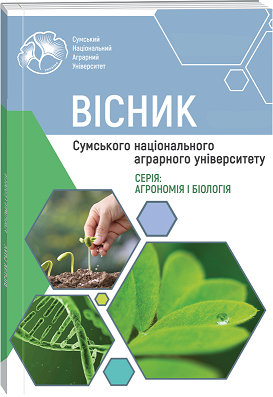ДОСЛІДЖЕННЯ ПРОТИГРИБНОЇ АКТИВНОСТІ ЕКСТРАКТУ ГІФ ШТАМУ STREPTOMYCES HU2014 ЩОДО ЧОТИРЬОХ ФІТОПАТОГЕННИХ ГРИБІВ
Анотація
Застосування хімічних пестицидів має багато недоліків, тому необхідні нові природні ресурси для регулювання розвитку хвороб рослин. Актинобактерії набувають інтересу для сільського господарства як агенти біологічної боротьби. Streptomyces spp. є частиною актинобактерій і відомі продукуванням великої кількості активних метаболітів. У цій роботі методом вимірювання швидкості росту досліджено протигрибну дію метанолового екстракту гіф (МЕГ) штаму Streptomyces HU2014 на чотири фітопатогенні гриби. Для визначення відповідного діапазону протигрибної активності було проведено попереднє тестування з різними концентраціями МЕГ. Результати показали, що ефект інгібування Rhizoctonia solani був кращим, ніж трьох інших грибів, і склав 100 % з концентрацією 0,5 мг/мл. На основі вищезазначеного тесту були отримані лінії регресії концентрації Log- пробіту відповідно до швидкості інгібування з різними концентраціями. Значення (50 % -відсоткової ефективної концентрації) EC50 МЕГ до R. solani через 48 годин, 72 години та 96 годин було найнижчим порівняно з іншими грибами. Рівняння регресії токсичності МЕГ на R. solani склало y = 6,9826 + 1,4028x (коефіцієнт кореляції r = 0,9783), а значення EC50 становило 0,0386 мг/мл через 72 години. Рівняння регресії токсичності МЕГ на Botrytis cinerea становило y = 5,6627 + 1,2386x (коефіцієнт кореляції r = 0,9614), а значення EC50 становило 0,2917 мг/мл через 72 години. Рівняння регресії токсичності МЕГ на Colletotrichum gloeosporioides склало y = 5,3143+1,0873x (коефіцієнт кореляції r = 0,9996), а значення EC50 становило 0,5140 мг/мл через 72 години. Рівняння регресії токсичності МЕГ на Fusarium graminearum склало y = 5,7011 + 2,3280x (коефіцієнт кореляції r = 0,9869), а значення EC50 становило 0,5024 мг/мл через 72 години. Штам Streptomyces HU2014 має значний протигрибний ефект і може стати новим агентом біоконтролю у сільськогосподарському виробництві.
Посилання
2. Breunig, M., & Chilvers, M. I. (2021). Baseline sensitivity of Fusarium graminearum from wheat, corn, dry bean and soybean to pydiflumetofen in Michigan, USA. Crop Protection, 140, 6. doi: 10.1016/j.cropro.2020.105419
3. Cha, J. Y., Han, S., Hong, H. J., Cho, H., Kim, D., Kwon, Y., Kwon, S. K., Crusemann, M., Lee, Y. B., Kim, J. F., Giaever, G., Nislow, C., Moore, B. S., Thomashow, L. S., Weller, D. M., & Kwak, Y. S. (2016). Microbial and biochemical basis of a Fusarium wilt-suppressive soil. Isme Journal, 10(1), 119–129. doi: 10.1038/ismej.2015.95
4.Chaouachi, M., Marzouk, T., Jallouli, S., Elkahoui, S., Gentzbittel, L., Ben, C., & Djebali, N. (2021). Activity assessment of tomato endophytic bacteria bioactive compounds for the postharvest biocontrol of Botrytis cinerea. Postharvest Biology and Technology, 172, 18. doi: 10.1016/j.postharvbio.2020.111389
5. Cubeta, M. A., & Vilgalys, R. (1997). Population Biology of the Rhizoctonia solani Complex. Phytopathology, 87(4), 480-484. doi:10.1094/PHYTO.1997.87.4.480
6. Deacon, J. W., & Berry, L. A. (1993). Biocontrol of soil borne plant pathogens: Concepts and their application. Pesticide Science, 37(4), 417–426.
7. Dias, M. P., Bastos, M. S., Xavier, V. B., Cassel, E., Astarita, L. V., & Santarém, E. R. (2017). Plant growth and resistance promoted by Streptomyces spp. in tomato. Plant Physiology and Biochemistry, 118, 479–493. doi: 10.1016/j.plaphy.2017.07.017
8. Grossmann, L., Ebert, S., Hinrichs, J., & Weiss, J. (2018). Effect of precipitation, lyophilization, and organic solvent extraction on preparation of protein-rich powders from the microalgae Chlorella protothecoides. Algal research, 29, 266–276. doi: 10.1016/j.algal.2017.11.019
9. Hadacek, F., & Greger, H. (2000). Testing of antifungal natural products: methodologies, comparability of results and assay choice. Phytochemical Analysis, 11(3), 137–147. doi: 10.1002/(SICI)1099-1565(200005/06)11:3<137::AIDPCA514> 3.0.CO;2-I
10. Hu, H. R., Wang, A., Qiu, L. L., Wang, X. B., Chen, M., Lu, A. M., & Yang, C. L. (2020). Novel pyrrolidine-2,4-dione derivatives containing pharmacophores of both hydrazine and diphenyl ether as potential antifungal agents: design, synthesis, biological evaluation, and 3D-QSAR study. New Journal of Chemistry, 44(46), 20071–20082. doi: 10.1039/d0nj04551a
11. Hu, M. J., Gao, Z. Y., Zhang, Z. K., Yang, F. Z., & Lia, M. (2013). Resistance of Botryodiplodia theobromae to Carbendazim and the Fungicides Screening for Mango Stem End Rot Control. In P. Lu (Ed.), Ix International Mango Symposium, 992, 407–414. Leuven 1: Int Soc Horticultural Science.
12. Jiao, J., Chen, M., Sun, S. X., Si, W. J., Wang, X. B., Ding, W. J., Fu, X. C., Wang, A., & Yang, C. L. (2021). Synthesis, Bioactivity Evaluation, 3D-QSAR, and Molecular Docking of Novel Pyrazole-4-carbohydrazides as Potential Fungicides Targeting Succinate Dehydrogenase. Chinese Journal of Chemistry, 39(2), 323–329. doi: 10.1002/cjoc.202000438
13. Jiao, R. H., Xu, H., Cui, J. T., Ge, H. M., & Tan, R. X. (2013). Neuraminidase Inhibitors from marine-derived actinomycete Streptomyces seoulensis. Journal of Applied Microbiology, 114(4), 1046–1053. doi: 10.1111/jam.12136
14. Katz, L., & Baltz, R. H. (2016). Natural product discovery: past, present, and future. J. Ind. Microbiol . Biotechnol., 43(2–3), 155–176. doi: 10.1007/s10295-015-1723-5
15. Li, J. L., Liu, X. Y., Xie, J. T., Di, Y. L., & Zhu, F. X. (2015). A Comparison of Different Estimation Methods for Fungicide EC50 and EC95 Values. Journal of Phytopathology, 163(4), 239–244. doi: 10.1111/jph.12312
16. Li, M., Chou, J., King, K. W., Jing, J., Wei, D., & Yang, L. Y. (2015). ICECAP: An Integrated, General-Purpose, Automation-Assisted IC50/EC50 Assay Platform. Jala, 20(1), 32–45. doi: 10.1177/2211068214562449
17. Liang, H. J., Li, J. L., Di, Y. L., Zhang, A. S., & Zhu, F. X. (2015). Logarithmic Transformation is Essential for Statistical Analysis of Fungicide EC50 Values. Journal of Phytopathology, 163(6), 456-464. doi:10.1111/jph.12342
18. Lu, D., Ma, Z., Xu, X., & Yu, X. (2016). Isolation and identification of biocontrol agent Streptomyces rimosus M527 against Fusarium oxysporum f. sp. cucumerinum. J Basic Microbiol, 56(8), 929–933. doi: 10.1002/jobm.201500666
19. Macaulay, S. J., Hageman, K. J., Piggott, J. J., & Matthaei, C. D. (2021). Imidacloprid dominates the combined toxicities of neonicotinoid mixtures to stream mayfly nymphs. Science of the Total Environment, 761, 8. doi:10.1016/j.scitotenv.2020.143263
20. McCulloch, M. J., Gauthier, N. W., & Vaillancourt, L. J. (2020). First Report of Bitter Rot of Apple Caused by a Colletotrichum sp. in the C. kahawae Clade in Kentucky. Plant Disease, 104(1), 289–290. doi: 10.1094/pdis-06-19-1247-pdn
21. Patel, J. K., Madaan, S., & Archana, G. (2018). Antibiotic producing endophytic Streptomyces spp. colonize aboveground plant parts and promote shoot growth in multiple healthy and pathogen-challenged cereal crops. Microbiological Research, 215, 36–45. doi: 10.1016/j.micres.2018.06.003
22. Peng, D., Li, S. D., Chen, C. J., & Zhou, M. G. (2014). Combined application of Bacillus subtilis NJ-18 with fungicides for control of sharp eyespot of wheat. Biological Control, 70, 28–34. doi: 10.1016/j.biocontrol.2013.11.013
23. Rani, L., Thapa, K., Kanojia, N., Sharma, N., Singh, S., Grewal, A. S., Srivastav, A. L., & Kaushal, J. (2021). An extensive review on the consequences of chemical pesticides on human health and environment. Journal of Cleaner Production, 283, 33. doi: 10.1016/j.jclepro.2020.124657
24. Tarkka, M., & Hampp, R. (2008). Secondary Metabolites of Soil Streptomycetes in Biotic Interactions. In P. Karlovsky (Ed.), Secondary Metabolites in Soil Ecology. Berlin, Heidelberg: Springer Berlin Heidelberg, 107–126.
25. Thabard, M., Gros, O., Hellio, C., & Maréchal, J.-P. (2011). Sargassum polyceratium (Phaeophyceae, Fucaceae) surface molecule activity towards fouling organisms and embryonic development of benthic species. 54(2), 147–157. doi: 10.1515/bot.2011.014
26. Tian, Z. K., & Kong, H. F. (2007). Current situation and development trend of biopesticides in China. Shanxi science and technology(3), 6–7. doi: 10.3969/j.issn.1004-6429.2007.03.003
27. Viaene, T., Langendries, S., Beirinckx, S., Maes, M., & Goormachtig, S. (2016). Streptomyces as a plant's best friend? FEMS microbiology ecology, 92(8). doi: 10.1093/femsec/fiw119
28. Wan, M., Li, G., Zhang, J., Jiang, D., & Huang, H.-C. (2008). Effect of volatile substances of Streptomyces platensis F-1 on control of plant fungal diseases. Biological Control, 46(3), 552–559. doi: 10.1016/j.biocontrol.2008.05.015
29. Wang, F., Yang, S., Wang, Y. S., Zhang, B., Zhang, F., Xue, H., Jiang, Q., & Ma, Y. (2021). Overexpression of Chitinase gene enhances resistance to Colletotrichum gloeosporioides and Alternaria alternata in apple (Malus x domestica). Scientia Horticulturae, 277(3), 8. doi: 10.1016/j.scienta.2020.109779
30. Wei, H. Y., Cai, L. M., Zhao, Y. Y., Zhou, M. C., & Tan, T. Y. (2008). Current Situation of the Microbial Pesticide in China. Arid Environmental Monitoring.
31. Wu, Z. M., Yang, Y., & Li, K. T. (2019). Antagonistic activity of a novel antifungalmycin N2 from Streptomyces sp. N2 and its biocontrol efficacy against Rhizoctonia solani. Fems Microbiology Letters, 366(3), 1-8. doi: 10.1093/femsle/fnz018
32. Xu, G.-F., Song, B.-A., Bhadury, P. S., Yang, S., Zhang, P.-Q., Jin, L.-H., Xue, W., Hu, D.-Y., & Lu, P. (2007). Synthesis and antifungal activity of novel s-substituted 6-fluoro-4-alkyl(aryl)thioquinazoline derivatives. Bioorganic & Medicinal Chemistry, 15(11), 3768–3774. doi: 10.1016/j.bmc.2007.03.037
33. Xu, S. Q., Wang, J. H., Wang, H. X., Bao, Y. X., Li, Y. S., Govindaraju, M., Yao, W., Chen, B. S., & Zhang, M. Q. (2019). Molecular characterization of carbendazim resistance of Fusarium species complex that causes sugarcane pokkah boeng disease. Bmc Genomics, 20, 14. doi: 10.1186/s12864-019-5479-6
34. Yan, Y. K., Cheng, W., Xiao, T. T., Zhang, G. L., Zhang, T. T., Lu, T., & Tang, X. R. (2020). Discovery of Novel 2,4,6-Trisubstituted Pyrimidine Derivatives as Succinate Dehydrogenase Inhibitors. Chinese Journal of Organic Chemistry, 40(12), 4237–4248. doi: 10.6023/cjoc202005057
35. Yang, C. J., Gao, Y., Du, K. Y., & Luo, X. Y. (2020). Screening of 17 Chinese medicine plants against phytopathogenic fungi and active component in Syzygium aromaticum. Journal of Plant Diseases and Protection, 127(2), 237–244. doi: 10.1007/s41348-019-00285-x

 ISSN
ISSN  ISSN
ISSN 


